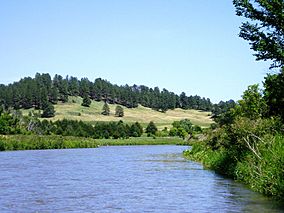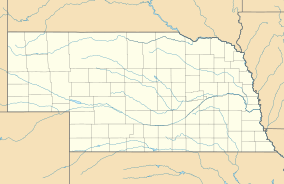Niobrara National Scenic River facts for kids
Quick facts for kids Niobrara National Scenic River |
|
|---|---|

Niobrara National Scenic River in 2003
|
|
| Location | Cherry, Keya Paha, Brown, and Rock counties, Nebraska, USA |
| Nearest city | Valentine, NE |
| Area | 23,074 acres (93.38 km2) |
| Established | May 24, 1991 |
| Visitors | 54,385 (in 2004) |
| Governing body | National Park Service |
| Website | Niobrara National Scenic River |
| Type: | Scenic, Recreational |
| Designated: | May 24, 1991 |
The Niobrara National Scenic River is a special part of a river in north-central Nebraska, United States. It's about 300 miles (480 km) northwest of Omaha. In 1991, the U.S. Congress decided to protect 76 miles (120 km) of this river. The National Park Service helps manage it, working with a local group called the Niobrara Council.
This river is protected because it has many "outstandingly remarkable values." These include its amazing plants and animals, beautiful views, interesting fossils, unique geology, and fun recreation activities. Backpacker magazine even named the Niobrara one of the top 10 rivers in the U.S. for canoeing!
Contents
Exploring the Niobrara River
The Niobrara National Scenic River is famous for its many waterfalls. These waterfalls tumble into the river from the cliffs and canyon walls around it. The tallest one is Smith Falls, which drops almost 63 feet (19 m) into the river valley.
River Adventures and Activities
You can find some exciting parts of the river with small rapids. These are called Class I and II rapids. There are also a few spots further downstream where you might need to carry your boat around the rapids.
The first 26 miles (40 km) of the Scenic River section are great for water fun. This part is from the Fort Niobrara National Wildlife Refuge (near Valentine) to the Rocky Ford portage. It's perfect for canoeing, kayaking, and tubing. About 75,000 people visit the river each year. The busiest months are June, July, and August. Even if water levels drop a bit in late summer, you can still enjoy the river.
To get to the first public access point, drive northeast of Valentine on Nebraska Highway 12. Look for the sign for the Fort Niobrara National Wildlife Refuge.
Amazing Plants and Animals
The Niobrara River is a truly special place for nature. It's considered an amazing example of a Great Plains river. Over 500 different plant species grow here. Many of these plants are found at the edge of their normal growing areas. Some are not naturally found within hundreds of miles of this river!
Unique Plant Life
The Niobrara is home to many different types of plants. You can find birch trees, ponderosa pine trees, and a rare type of aspen tree here. Six different kinds of plant communities grow close together in this area.
- Northern Boreal Forests: On slopes that face north, you'll find cooler, shadier spots with lots of groundwater. Plants like paper birch, aspen, ferns, and club mosses grow here.
- Rocky Mountain Forests: These areas have plants like ponderosa pine, serviceberry, and horizontal juniper.
- Eastern Deciduous Forests: These grow in the moist lowlands and on islands in the river. They include trees like American elm, basswood, cottonwood, and bur oak.
- Prairies: Three types of prairie grasslands are found in the river valley. These show a mix of eastern tallgrass prairie, Sandhills mixed-grass prairie, and Northern Mixed-grass prairie.
Wildlife of the Niobrara
Many different animals live in the Niobrara area. You might spot mule deer, beaver, mink, pronghorn, and river otter. You can even find bison here!
About 300 bison and a few dozen elk are protected in the Fort Niobrara National Wildlife Refuge. This refuge is 19,000 acres (77 km²) and is located right along the river.
Fish and Aquatic Life
The Niobrara River is also home to many fish and other water creatures.
- Minnows: Small fish like sand shiners, red shiners, and flathead chubs look for food near the riverbanks. They mostly eat aquatic insects.
- Trout: Larger fish, such as rainbow and brown trout, like cooler, clear water. You'll often find them where smaller streams flow into the river.
- Catfish: Channel catfish are popular for fishing. They prefer deeper water or hiding spots during the day. At night, they feed in the faster-moving parts of the river.
- Turtles: In the summer, you might see softshell, snapping, or painted turtles sunning themselves on logs in the water.
Historic Bridges
The Niobrara National Scenic River has 15 bridges that cross it. Six of these bridges are very old and important. They are listed on the National Register of Historic Places, which means they are protected because of their history.
Images for kids




